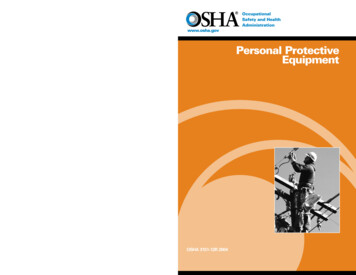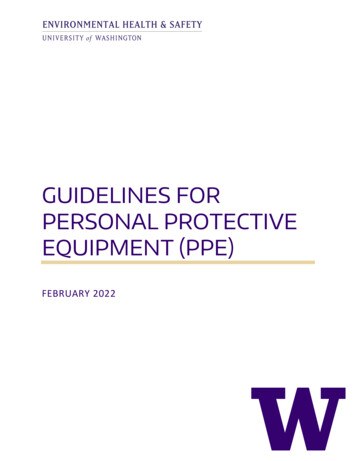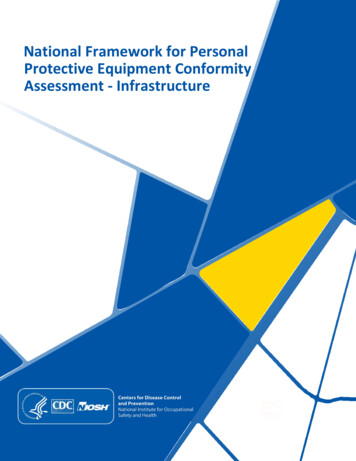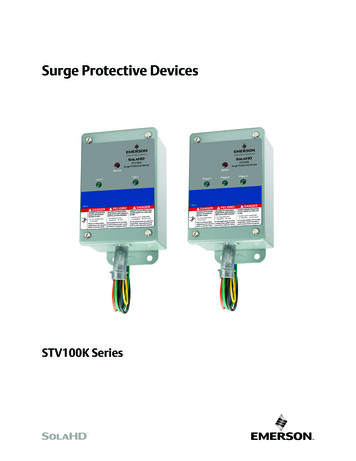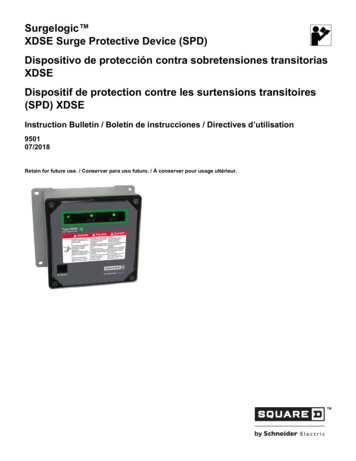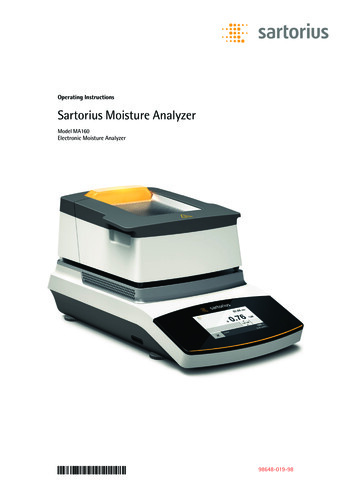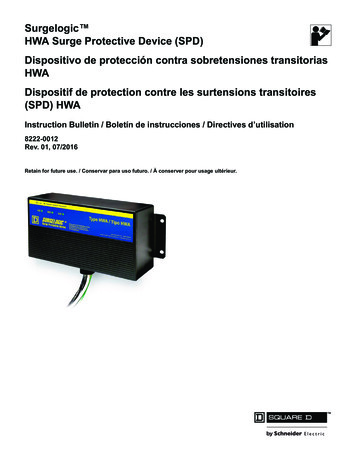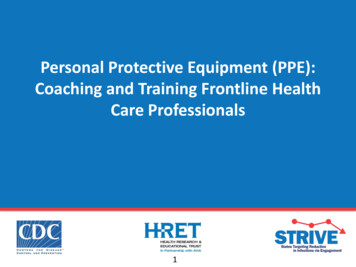
Transcription
Personal Protective Equipment (PPE):Coaching and Training Frontline HealthCare Professionals1
PresenterLona Mody, MD, MScAmanda Sanford Hickey Professor of MedicineUniversity of MichiganAnn Arbor VA Ann Arbor GRECCContributions byLinda R. Greene, RN, MPS, CICUniversity of Rochester Medical CenterHighland HospitalKaren Jones, RN, MPHSt. John Hospital and Medical Center2
Learning Objectives Review the basic principles of PersonalProtective Equipment (PPE) use in healthcare settings Discuss models of engagement to enhancestaff education for PPE use3
Infection TransmissionChain of Infection(Adapted by R. Olmsted from Principles ofEpidemiology in Public Health Practice, CDC,2012)4
Types of PPE in Health CareGloves – protect hands and allow efficient removal of organisms from handsGowns and Aprons – protect skin and clothingFace masks– protect mucous membranes of mouth and noseRespirators- prevent inhalation of infectious materialGoggles – protect eyesFace shields – mucous membranes of face, mouth, nose and eyes5
Principles for PPE UseDon before contact with the patient– Generally before entering the roomRemove and discard PPE carefullyAfter doffing, immediately perform hand hygiene6
PRECEDE Model(Mody L et al., CID, 2011)7
Apply 4 E Model(Prenovost P et al., BMJ, 2008; Saint S et al., ICHE, 2010)8
EngageHave a conversationUse team meetings or huddlesSolicit feedback from staff:– Why is PPE use important?– What are the barriers to consistent PPE use?– Use recent outbreaks as conversation starters Ebola epidemic C. diff outbreak– Discuss facility-specific MDRO challenges9
How Will You Help Engage YourFacility? Nominate unit champions Assess staff knowledge Use this as your QualityImprovement project Audit adherence Give positive feedback Hold unit level competitions, givesome simple prizes to winners(CDC, Transmission-Based Precautions, ission-basedprecautions.html#anchor 1564058318 )10
Take the Pledge (APIC Take the Pledge is available at:http://www.apic.org/Resource /TinyMceFileManager/Resources/APIC HRET Take the Pledge FINAL 5-15.pdf)11
Educate: Share evidenceContaminationAfter ands AfterGlove Removal(Snyder G et al., ICHE, 2008; Roghmann M et al., ICHE 2015; Grabsch E et al., ICHE, 2006; Zachary K et al., ICHE, 2001)12
Healthcare Contamination Varies by Typeof Care(Roghmann M et al., ICHE, 2015)13
Execute Engage senior leaders Share content at your next in-service Make posters of your staff engaging inpositive behaviors, hang them up in keycommon areas Hold live demonstrations on appropriatePPE use14Role model positive behaviors
Demonstrate Appropriate PPE UseDon PPE correctly and in the correct orderRemove and dispose of PPE correctly andwithout contaminationRemember hand hygiene before and after!Simulate contamination(e.g. fluorescent glow solution, iodine solution , chocolatesyrup, etc.)15
Contamination During PPE Removal(Tomas M et al., JAMA Intern Med, 2015)16
Evaluate(WHO: http://www.who.int/gpsc/5may/Observation Form.doc?ua 1TIP Toolkit: C: modialysis-Hand-Hygiene-Observations.pdf )17
Key PointsSafe PPE use has captured national attentionAppropriate use is critical to prevent transmission ofpathogensApply innovative models such as 4E or PRECEDE Modelsto enhance staff training and education18
ReferencesCDC Dialysis Collaborative. Audit Tool: Hemodialysis Hand Hygiene Observations. Centers for Disease Control and Prevention, CDC. Available Hemodialysis-Hand-Hygiene-Observations.pdfClean Hands Save Lives. Observation Form. World Health Organization, WHO. Revised 2009. Available athttp://www.who.int/gpsc/5may/Observation Form.doc?ua 1Grabsch EA, Burrell LJ, Padiglione A, et al. Risk of environmental and healthcare worker contamination with vancomycin-resistant enterococci during outpatientprocedures and hemodialysis. Infect Control Hosp Epidemiol. 2006; 27(3): 287-93.Hand Hygiene Monitoring Tool. Tip Toolkit. Available at dy L, Bradley SF, Galecki A, et al. Conceptual model for reducing infections and antimicrobial resistance in skilled nursing facilities: focusing on residents withindwelling devices. Clinical Infectious Diseases. 2011; 52(5): 654-651.Principles of Epidemiology in Public Health Practice, Third Edition.An Introduction to Applied Epidemiology and Biostatistics. Centers for Disease Control and Prevention, CDC. Reviewed May 18, 2012. Accessed July 1, 2016.Available at 1/section10.htmlPronovost PJ, Berenholtz SM, Needham DM. Translating evidence into practice: a model for large scale knowledge translation. BMJ. 2008; 337: a1714.Roghmann MC, Johnson JK, Sorkin JD, et al. Transmission of Methicillin-Resistant Staphylococcus aureus (MRSA) to Healthcare Worker Gowns and Gloves DuringCare of Nursing Home Residents. Infect Control Hosp Epidemiol. 2015; 36(9): 1050-7.Saint S, Kowalski CP, Banaszak-Holl J, et al. The importance of leadership in preventing healthcare-associated infection: results of a multisite qualitative study. InfectControl Hosp Epidemiol. 2010; 31(9): 901-7.Siegel JD, Rhinehart E, Jackson M, et al. 2007 Guideline for Isolation Precautions: Preventing Transmission of Infectious Agents in Healthcare Settings. Available on2007.pdfSnyder GM, Thom KA, Furuno JP, et al. Detection of methicillin-resistant Staphylococcus aureus and vancomycin-resistant enterococci on the gowns and gloves ofhealthcare workers. Infect Control Hosp Epidemiol. 2008; 29(7): 583-9.Take the Pledge. Association for Professionals in Infection Control. Available at:http://www.apic.org/Resource /TinyMceFileManager/Resources/APIC HRET Take the Pledge FINAL 5-15.pdf)Toma ME, Kundrapu S, Thota P, et al. Contamination of Health Care Personnel During Removal of Personal Protective Equipment. JAMA Intern Med. 2015; 175(12):1904-10.Zachary KC, Bayne PS, Morrison VJ, et al. Contamination of gowns, gloves, and stethoscopes with vancomycin-resistant enterococci. Infect Control Hosp Epidemiol.2001; 22(9): 560-4.19
Speaker Notes20
Speaker Notes: Slide 1Welcome to today’s training module, titled “Personal ProtectiveEquipment: Coaching and Training Frontline Health CareProfessionals.” During this training module, we will reviewstrategies to coach and train frontline health care professionalsin the use of personal protective equipment and health careprecautions to prevent healthcare-associated infections or HAIs.21
Speaker Notes: Slide 2This module was developed by national infection preventionexperts devoted to improving patient safety and infectionprevention efforts.22
Speaker Notes: Slide 3There are two main objectives for this module. The first is toreview the basic principles of personal protective equipment,also known as PPE, use in health care settings. The second is todiscuss models of engagement to enhance staff education forPPE use. Understanding these two core objectives will set thegroundwork to improve the culture of safety related to infectionprevention in your health care organization.23
Speaker Notes: Slide 4Correct use of appropriate PPE is an essential component todisrupt the chain of infection and stop disease transmission.Helping personnel understand infection transmission canfacilitate correct PPE use to break the chain of infection.As a review, infectious agents live and grow in a reservoir, like apatient’s GI tract, nose or wounds. Pathogens exit the reservoirvia a portal of exit. This might be in feces, by coughing orsneezing, or by wound drainage. Microbes can “go mobile” andmove from place to place – they may be transmitted by healthcare worker’s hands, contaminated environmental surfaces orequipment that is shared among the patients. Once a harmfulmicrobe reaches that person it only takes a portal of entry, a wayin, to infect somebody else. That person can serve as a reservoir.24
Speaker Notes: Slide 5Personal protective equipment –or PPE as I mentioned earlier–are worn to disrupt this chain of infection. PPE should beselected based on the type of precautions the patient is under.And, staff should always follow Standard Precautions in additionto any transmission-based precautions when caring for patients.It is important that all staff are trained in correct PPE use,including when to use different types of PPE, both putting onand taking off procedures, reviewing where different PPE itemsare kept and how supplies should be restocked if they arerunning low. During staff training it is essential to review yourhospital’s policies for initiating various precautions.25
Speaker Notes: Slide 6This slide shows a couple key points to emphasize with staffduring training. First, when indicated, you should put on theappropriate PPE before any contact with the patient. Many timesthis will be directly before entering the patient’s room. Handhygiene should be done before putting on PPE. After providingcare, PPE for contact precautions should be removed carefully;as this is often when the contamination occurs. PPE, for contactprecautions, should be removed at the doorway of the patient’sroom or immediately outside the room. Lastly, hand hygieneshould be performed immediately after removing the PPE. Formore about hand hygiene, please review the Hand Hygienecourse.26
Speaker Notes: Slide 7The remainder of this module will explore innovative strategiesthat can be used to enhance your staff training and educationaround PPE use.I will begin by discussing the PRECEDE Model and how it can beadapted for strengthening your PPE program and staff training.In this model we can break the educational diagnosis stage intopredisposing aspects, enabling factors and reinforcing factors.These issues, if identified, modified and strengthened will lead tobehavior change and sustained program success.27
Speaker Notes: Slide 7 ContinuedPredisposing aspects are personnel’s beliefs, attitudes andopinions about PPE practices. Enabling factors are elements inthe environment that empower staff to model a certainbehavior, in this instance proper PPE use. This includes PPEplacement, access and ease of use. Lastly we reinforce desiredbehaviors with regular feedback on appropriate PPE use,leadership engagement, behavior modeling and rewards forconsistent and effective PPE use.Furthermore, evaluating outcomes will inform you if your effortsare successful.28
Speaker Notes: Slide 8Similarly, a 4E Model is a framework to guide leaders in theirchange efforts. To successfully implement and lead change,educators need to Engage, Educate, Execute and Evaluate, the4Es. We will discuss each of these Es in more detail on thefollowing slides.29
Speaker Notes: Slide 9How can you engage staff about improving and enhancing PPEpractice at your hospital or in your unit? It can begin with asimple conversation.Use existing team meetings or huddles to solicit staff feedbackon the PPE practices and policies at your facility and emphasizethe importance of PPE. Hospital or unit specific outbreaks,MDRO challenges and data can help illustrate the importance ofPPE and initiate this conversation. It is important to rememberthat you don’t have to come up with all the answers. Ask staffwhat they believe are the barriers for consistent PPE use.30
Speaker Notes: Slide 9 ContinuedWhat do staff think would help them and their colleagues moreeffectively and consistently use appropriate precautions? Byengaging staff and gathering their input and feedback you willhelp create staff ownership of the policy, which will thenstrengthen behavior change and lead to sustainability.31
Speaker Notes: Slide 10In addition to talking to staff, it is important to nominatechampions who can spearhead the initiative in your hospital orthe unit. Unit or project champions can help engage staff on adaily basis with the project. To learn about using champions,consider reviewing the course on Uber Adaptive Strategies forInfection Prevention.Engage staff by assessing their baseline knowledge of your PPEpolicies and procedures. This can be done through a simpleassessment quiz or by PPE demonstrations. We will discussaudits and evaluation of staff PPE skills in more detail in thefourth module of this course. Finally, consider holding unit levelcompetitions to engage staff and motivate buy-in.32
Speaker Notes: Slide 11APIC has developed an infection prevention tool, titled “Take thePledge.” This tool contains information on infection preventionskills to help stop the spread of infections. This tool can beprinted, displayed or disseminated as appropriate in your facilityto engage staff on new and existing infection preventionpractices and policies within your hospital.33
Speaker Notes: Slide 12Educate is the second of the 4Es of effective leadership.Here we address the question “What do the staff need toknow?” That is, why is PPE important? How will patientoutcomes improve by using PPE appropriately? How does thisaffect my daily work?Staff education should also include sharing the evidence. Youmay choose to share hospital, unit specific or national evidencefor the importance of PPE. This table highlights the level ofcontamination that can occur after caring for a patient who iscolonized or infected with MRSA and VRE.34
Speaker Notes: Slide 12 ContinuedStudies have shown that gloves can be contaminated after 18-24percent of care interactions for patients colonized or infectedwith MRSA, and up to 63 percent of care interactions in patientscolonized or infected with VRE. Gown contamination for MRSAoccurs up to 14 percent of the time, and VRE contamination upto 37 percent of the time. Despite glove use, hands can becontaminated after glove removal, which is why hand hygienefollowing removal of PPE is so critical.35
Speaker Notes: Slide 12 ContinuedThese studies also reveal that certain procedures and patientcare interactions are considered high risk for contamination. Forexample, staff contact with endotracheal tubing, the head or theneck of the patient and the presence of a feeding tube or piccline leads to contamination with both MRSA and VRE (Snyder etal. 2008). Our own studies from University of Michigan andUniversity of Maryland, show that providing wound care can leadto increased contamination (Roghmann). Furthermore, staff whocare for colostomy or ileostomy patients are at an increased riskfor VRE contamination (Zachary et al 2001). It is important thatduring staff training and education, you highlight these riskfactors for healthcare personnel contamination.36
Speaker Notes: Slide 13More data from our study reveals that different types of careactivities have different levels of transmission risk. In thisparticular study, investigators at University of Michigan andUniversity of Maryland, showed that when swabbing gowns andgloves of health care personnel after providing care to MRSAcolonized patients, there were several high-risk care activitiesthat increased MRSA contamination on gowns and gloves. Theseincluded changing linens, assisting with dressing, transferring,providing hygiene or bathing, and assisting with toileting or abrief change. On the other hand, giving medications orperforming glucose monitoring were found to be lower-risk careactivities for MRSA transmission.37
Speaker Notes: Slide 14The third E of effective leadership is Execute. How will youimplement PPE training and modifications?This slide includes a couple of key strategies to help you executePPE improvements in your hospital or your unit. First, it is important to engage senior leaders and garner theirsupport and buy-in. Please review the Uber Adaptive Coursemodule on Engaging Leaders for additional tips and strategies.38
Speaker Notes: Slide 14 Continued Second, consider how you will provide education and programrole out. You could have staff review modules 1 and 2 aboutStandard Precautions and Transmission-Based Precautions. Oryou can develop your own education and training as part of anin-service. Third, make posters highlighting key concepts and changes andhang them in key common areas. You can personalize theseposters by taking photographs of your staff engaging in positivebehaviors. Fourth, consider holding live demonstrations on appropriategown, glove and face mask use.39
Speaker Notes: Slide 15During live demonstrations it is important that staff can performthe following key components of effective PPE use. Staff should be able to put on PPE correctly and in the correctorder and remove and dispose of PPE correctly and withoutcontamination. It is also important to emphasize hand hygiene before and afterPPE use. Remind staff that PPE use is not a replacement forconsistent hand hygiene.40
Speaker Notes: Slide 15 ContinuedDuring demonstrations consider simulating pathogencontamination with fluorescent glow solution, iodine solution orchocolate syrup. Simulating contamination can help staffvisualize importance of proper use and removal and highlighthow easy it is to accidently contaminate yourself, if you are notcareful.41
Speaker Notes: Slide 16A study by Tomas in 2015 found that contamination of skin orclothing occurred in 46 percent of PPE simulations. Moreimportantly, contamination was more common followingcontaminated glove removal than contaminated gown removal.Contamination was also more likely when observers identifiedlapses in proper donning and doffing technique; 70 percentcontaminated during an observed lapse in technique versus only30 percent contamination occurred when no lapse wasobserved.42
Speaker Notes: Slide 17The last E is evaluation. As we discussed with the PRECEDEmodel, it is important to evaluate your change efforts. This slideshows three tools for PPE auditing. The one on the left by theWHO, the one on the bottom is by the CDC and the one on thetop right, my team has used for some of our patient-orientedresearch studies. These tools may be helpful in evaluating thestaff’s efforts to improve PPE use. Evaluation and auditing isdiscussed in greater detail in the next module on Auditing PPEUse.43
Speaker Notes: Slide 18As I wrap up this module, I would like to leave you with three keypoints about training, educating and engaging staff on PPE use.First, highlight that with the Ebola crisis, national attention hasbeen brought on the importance of PPE and the appropriate useis critical to prevent transmission and spread of pathogens.Second, by diligently using PPE, staff can be part of this nationaleffort. Lastly, consider applying an innovative approach, like the4E or PRECEDE models, to enhance staff training andengagement.44
Speaker Notes: Slide 19No Notes.45
Welcome to today’s training module, titled “Personal Protective Equipment: Coaching and Training Frontline Health Care Professionals.” During this training module, we will review strategies to coach and train frontline health care professionals in the use of

